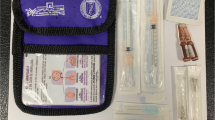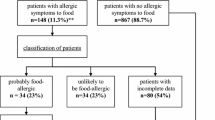Abstract
Self-administered adrenaline through an auto-injector is the main out-of-hospital treatment for anaphylaxis, and patients should be trained to promptly and correctly use the device. The aim of the study was to verify the proper use of the device and the correct drug administration, and to identify possible misuse by patients. In seven Italian Allergy clinics, patients who were previously provided with self-injectable adrenaline were recruited at the follow-up visit required for the renewal of their prescription. All patients completed a questionnaire covering details of their allergic reactions, and knowledge of the device. The correct use was verified by the physician using a trainer with a four-step examination. 242 patients were included; 46 patients (18 %) did not always carry the auto-injector, and 35 patients (14 %) reported situations in which they were doubtful about whether to use adrenaline. Only 39 % of patients properly managed the device, while some patients (6 %) failed in all four steps. The majority of patients considered it appropriate to use adrenaline at the onset of respiratory symptoms (56 %). The factor most closely related to proper use of the device was the education of the patient (p = 0.03), while age and the time from first prescription did not affect the ability to properly use the auto-injector. Even though accurate training is conducted, many patients are still unable to properly use the adrenaline auto-injector in case of anaphylaxis. Allergists should review the instructions provided to the patients every time a renewal of the auto-injector is prescribed.
Similar content being viewed by others
References
Simons FE, Ardusso LR, Bilò MB, El-Gamal YM, Ledford DK, Ring J, World Allergy Organization et al (2011) World Allergy Organization guidelines for the assessment and management of anaphylaxis. World Allergy Organ J 4:13–37
Panesar SS, Javad S, de Silva D, Nwaru BI, Hickstein L, Muraro A, EAACI Food Allergy and Anaphylaxis Group et al (2013) The epidemiology of anaphylaxis in Europe: a systematic review. Allergy 68:1353–1361
Pumphrey RSH (2000) Lessons for management of anaphylaxis from a study of fatal reactions. Clin Exp Allergy 30:1144–1150
Rudders SA, Banerji A (2013) An update on self-injectable epinephrine. Curr Opin Allergy Clin Immunol 13:432–437
Song TT, Worm M, Lieberman P (2014) Anaphylaxis treatment: current barriers to adrenaline auto-injector use. Allergy. doi:10.1111/all.12387
Simons FE (2004) First-aid treatment of anaphylaxis to food: focus on epinephrine. J Allergy Clin Immunol 113:837–844
Simons FE, Clark S, Camargo CA Jr (2009) Anaphylaxis in the community: learning from the survivors. J Allergy Clin Immunol 124:301–306
Noimark L, Wales J, Du Toit G, Pastacaldi C, Haddad D, Gardner J et al (2012) The use of adrenaline autoinjectors by children and teenagers. Clin Exp Allergy 42:284–292
Carrascosa MF, Gallastegui-Menéndez A, Teja-Santamaría C, Caviedes JR (2013) Accidental finger ischaemia induced by epinephrine autoinjector. BMJ Case Rep 2013:18. doi:10.1136/bcr-2013-200783
Simons FE, Ardusso LR, Bilò MB, Dimov V, Ebisawa M, El-Gamal YM, World Allergy Organization et al (2012) 2012 update: World Allergy Organization guidelines for the assessment and management of anaphylaxis. Curr Opin Allergy Clin Immunol 12:389–399
Banerji A, Rudders S, Clark S, Wei W, Long AA, Camargo CA Jr (2014) Retrospective study of drug-induced anaphylaxis treated in the emergency department or hospital: patient characteristics, management, and 1-year follow-up. J Allergy Clin Immunol Pract 2:46–51
Sclar DA, Lieberman PL (2014) Anaphylaxis: underdiagnosis, underreported, and undertreated. Am J Med 127(1 Suppl):A1–A5
Fineman S, Dowling P, O’Rourke D (2013) Allergists’ self-reported adherence to anaphylaxis practice parameters and perceived barriers to care: an American College of Allergy, Asthma and Immunology member survey. Ann Allergy Asthma Immunol 111:529–536
Muraro A, Roberts G, Simons FE (2008) New visions for anaphylaxis: an iPAC summary and future trends. Pediatr Allergy Immunol 19(Suppl 19):40–45
Rawas-Qalaji MM, Rachid O, Simons FE, Simons KJ (2013) Long-term stability of epinephrine sublingual tablets for the potential first-aid treatment of anaphylaxis. Ann Allergy Asthma Immunol 111:568–570
Sheikh A, Simons FE, Barbour V, Worth A (2012) Adrenaline auto-injectors for the treatment of anaphylaxis with and without cardiovascular collapse in the community. Cochrane Database Syst Rev 8:CD008935
Gold MS, Sainsbury R (2000) First aid anaphylaxis management in children who were prescribed an epinephrine autoinjector device (EpiPen). J Allergy Clin Immunol 106:171–176
Gallagher M, Worth A, Cunningham-Burley S, Sheikh A (2011) Epinephrine auto-injector use in adolescents at risk of anaphylaxis: a qualitative study in Scotland, UK. Clin Exp Allergy 41:869–877
Floxtra-de Blok BM, Doriene van Ginkel C, Roerdink EM, Kroeze MA, Stel AA, van der Meulen GN, Dubois AE (2011) Extremely low prevalence of epinephrine autoinjectors in high-risk food-allergic adolescents in Dutch high schools. Pediatr Allergy Immunol 22:374–377
Amirzadeh A, Verma P, Lee S, Klaustermeyer W (2010) Epinephrine auto-injector use and demographics in a veterans administration population. Allergy Asthma Proc 31:304–307
Money AG, Barnett J, Kuljis J, Lucas J (2013) Patient perception of epinephrine auto-injectors: exploring barriers to use. Scand J Caring Sci 27:335–344
Sicherer SH, Forman JA, Noone SA (2000) Use assessment of self-administered epinephrine among food-allergic children and pediatricians. Pediatrics 105:359–362
Topal E, Bakirtas A, Yilmaz O, Ertoy IH, Arga M, Demirsoy MS, Turktas I (2013) A real-life study on acquired skills from using an adrenaline autoinjector. Int Arch Allergy Immunol 160:301–306
Bonds RS, Asawa A, Ghazi AI (2015) Misuse of medical devices: a persistent problem in self-management of asthma and allergic disease. Ann Allergy Asthma Immunol 114:74–76
Segal N, Garty BZ, Hoffer V, Levy Y (2012) Effect of instruction on the ability to use a self-administered epinephrine injector. Isr Med Assoc J 14:14–17
Guerlain S, Hugine A, Wang L (2010) A comparison of 4 epinephrine autoinjector delivery: usability and patient preference. Ann Allergy Asthma Immunol 104:172–177
Camargo CA Jr, Guana A, Wang S, Simons FE (2013) Auvi-Q versus EpiPen: preferences of adults, caregivers, and childrens. J Allergy Clin Immunol Pract 1:266–272
Bakirtas A, Arga M, Catal F, Derinoz O, Demirsoy MS, Turktas I (2011) Make-up of the epinephrine autoinjector: the effects on its use by untrained users. Pediatr Allergy Immunol 22:729–733
Conflict of interest
The authors declare that they have no conflict of interest.
Statement of human and animal rights
The study was approved by the Ethical Committee of Guglielmo da Saliceto Hospital, Piacenza, Italy.
Informed consent
Informed consent was obtained from all individual participants included in the study.
Author information
Authors and Affiliations
Corresponding author
Rights and permissions
About this article
Cite this article
Ridolo, E., Montagni, M., Bonzano, L. et al. How far from correct is the use of adrenaline auto-injectors? A survey in Italian patients. Intern Emerg Med 10, 937–941 (2015). https://doi.org/10.1007/s11739-015-1255-z
Received:
Accepted:
Published:
Issue Date:
DOI: https://doi.org/10.1007/s11739-015-1255-z




